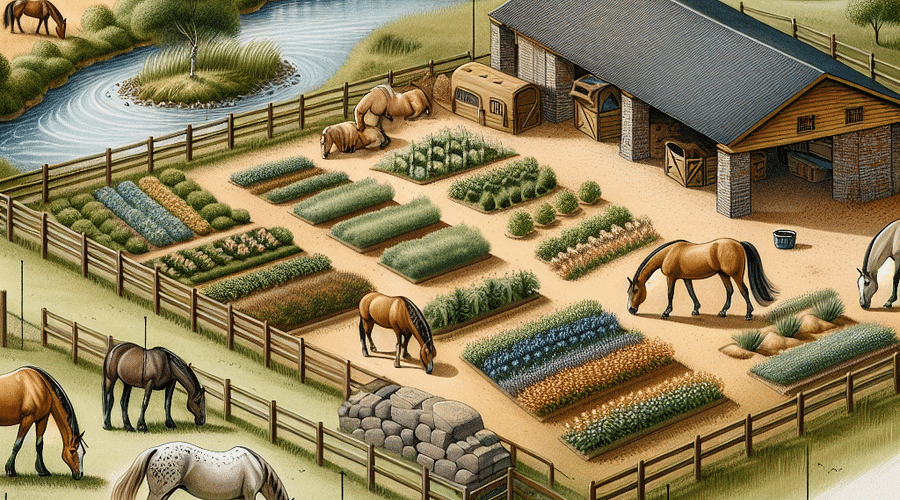Strategic Landscaping for Horse Properties: Creating Safe and Stimulating Environments for Horses

When it comes to creating a haven for our equine companions, the significance of strategic landscaping cannot be overstated. Not only does it contribute to the aesthetic appeal of your horse property, but it also plays a crucial role in ensuring the safety and stimulation of your horses. A well-designed landscape is an amalgamation of beauty and functionality, providing a serene environment that caters to the natural instincts and needs of horses.
At the heart of any horse-friendly landscape is safety. The right layout and plant selections can prevent accidents, discourage harmful behaviors, and promote a healthy lifestyle for your horses. To begin with, fencing should be designed to be both secure and visible to equines. Toxic plants must be meticulously identified and removed to prevent ingestion. Moreover, incorporating non-slip surfaces on walkways can greatly reduce the risk of injury.
For those eager to dive deeper into crafting a secure environment, our guide on Horse Property Landscaping Ideas offers a treasure trove of inspiration. Additionally, understanding land requirements is essential; take our quiz to see if you're on the right track with your current setup.
Horses are inherently curious and benefit from an environment that challenges them both mentally and physically. Strategic landscaping can include features such as varied terrain with hills for muscle development or water elements for sensory stimulation. Trees and shrubs not only provide shade but can also serve as natural obstacles that encourage exploration and play.
A stimulating environment goes hand in hand with sustainable practices. Our guide on Green Horse Property Management offers insights into eco-friendly practices that enrich your horse's habitat while preserving nature.
The wellbeing of horses extends beyond basic needs; it encompasses their psychological health as well. Incorporating features such as communal grazing areas encourages social interaction, which is vital for their mental health. Shelter structures like run-in sheds protect them from harsh weather conditions while allowing freedom of movement.










To ensure you're making informed decisions about your property's layout, consider exploring our step-by-step guide on Designing Your Multi-generational Horse Property. And remember, even if space is limited, our article on keeping a horse in a 2-acre yard will show you how to maximize your land effectively.
In conclusion—well, not quite yet! We still have more ground to cover when it comes to strategic landscaping for horse properties. Stay tuned as we delve further into topics like integrating native plants into your design, managing pasture rotation effectively, and choosing the right amenities that make your property stand out in the equestrian community.
Water is a vital element in any landscape, and incorporating it into your horse property can be both aesthetically pleasing and functional. A pond or small stream not only adds to the beauty of the property but can also be a natural water source for your horses. However, it's crucial to design these features with safety in mind. Sloped edges and non-slip surfaces will ensure horses can access water without risk of injury.
Equally important is an effective drainage system to prevent waterlogging, which can lead to hoof issues such as thrush. Strategic placement of ditches and grading the land will ensure that water runs away from high-traffic areas. This proactive approach minimizes mud and maintains a healthier environment for your equine companions.
Selecting the right vegetation for your horse property is about more than just curb appeal—it's about creating a safe and nutritious landscape for your horses. While lush pastures are ideal, it's essential to recognize that not all plants are horse-friendly. Some may be toxic, so research and careful selection are paramount.










In addition to avoiding toxic plants, consider planting native species that thrive in your region's climate with minimal intervention. These plants are often more resistant to local pests and diseases, reducing the need for chemical treatments that could harm your horses.
The right fencing on a horse property serves two primary functions: keeping horses safe within their designated areas and allowing them clear visibility beyond their enclosures. Fences should be sturdy enough to withstand the occasional nudge or scratch from a curious equine but also designed to prevent injuries with smooth finishes and appropriate heights.
Incorporating hedgerows alongside fences not only enhances privacy but also provides natural windbreaks and contributes to the overall ecosystem by supporting wildlife—a win-win for eco-conscious equestrian property owners.
To wrap up, strategic landscaping on a horse property should prioritize safety while stimulating your horses' senses. Water features must be designed with gentle slopes; plant life should be carefully selected for its non-toxicity; fences ought to balance security with visibility; each element thoughtfully contributing to the holistic wellbeing of your horses.
If you're ready to take on landscaping for your own property or simply want more information on creating an optimal environment for your equine friends, explore our comprehensive guides like Transitioning to a Green Horse Property, or test your knowledge with our interactive quizzes such as Horse Property Landscaping Ideas Quiz. And remember, whether you're designing from scratch or upgrading existing features, every choice you make impacts not just the beauty but also the functionality and safety of your equestrian haven.
Test your knowledge on creating a safe and stimulating environment for horses through strategic landscaping. Choose the best answer for each question about integrating safe landscaping features into horse properties.
Post a comment